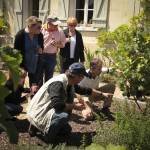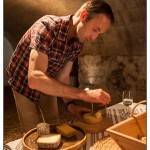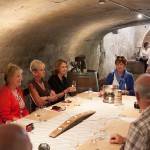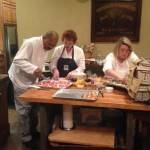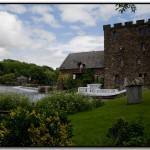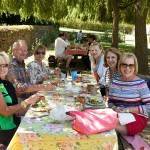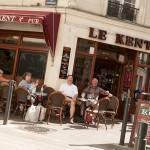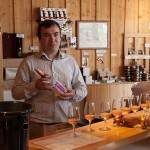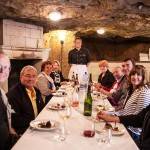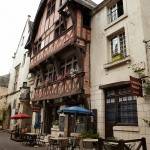Skip to content
2018 Itinerary- French Culinary and Wine Adventure with Chef WalterWalter Eagleton2017-07-14T14:19:25-05:00
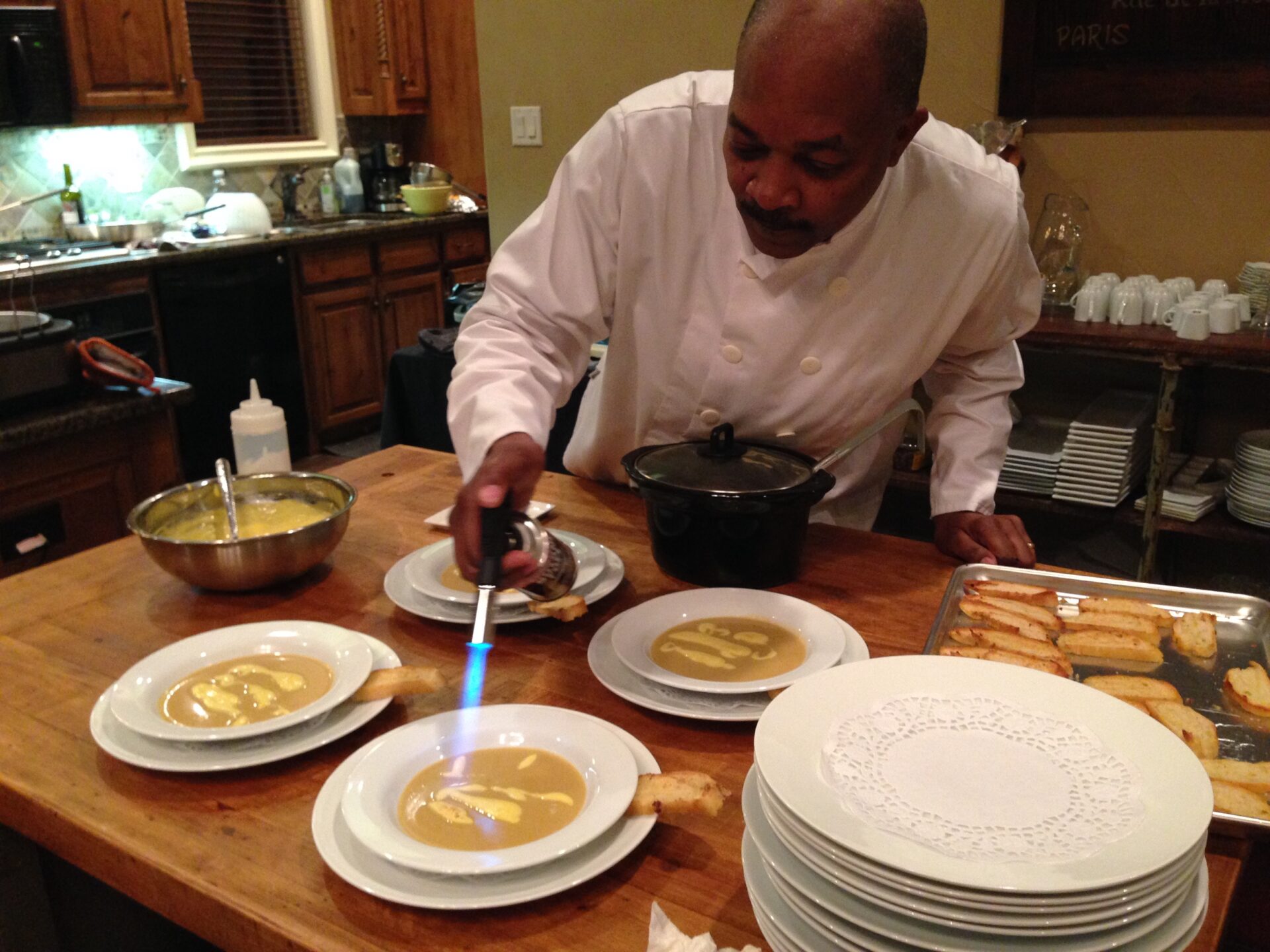
Sunday, July 22 – Saturday, July 28, 2018

Sunday
We will meet you at Charles de Gaulle Airport or the Tours rail station in the afternoon and transport you to your Chateau home for the week. Enjoy a meet-and-greet with homemade hors d’oeuvres and locally produced wines, followed by a tour of the Chateau. Then relax around the luxurious pool or explore the estate until it is time for an “Opening Night” Gourmet 5-course Welcome dinner. Dinner prepared by Chef Walter and Artistic Gourmet Adventures.
Monday
After we enjoy a delicious breakfast by Artistic Gourmet Adventures, Chef Walter will lead you in hands-on preparation for lunch and dinner.
-
Hands-on Bread making\Chicken Butchery
-
Chicken Stock Knife Skills
-
Hands-on lunch prep: Soufflé au Comte (Franche-Comte)
-
Lunch Menu
Souffé au Comte
Salad of Chilled Julienne Vegetables
Local Pastry
-
After lunch: Soup, Sorbet Demo (Spiced Cauliflower)
-
Hands-on prep for tonight’s dinner and prep Coq Au Vin to tomorrow’s dinner.
-
Dinner Menu
Canapé of Smoked Salmon Mousse
Potage Parmentier
Oven Baked Filet de lieu Jaune with a melange of Steamed Vegetables and Lemon Butter Foam
Duo of Lemon Tart and Raspberry Sorbet
Selection of Homemade Breads
Tuesday
Breakfast prepared by Artistic Gourmet Adventures. Then Chef Walter will lead you in prepping for tonight’s menu. We will then journey to a little town on the Loire River to enjoy a visit to a local English-speaking wine expert and viticulturist couple. The day begins with coffee and sweets, and includes a comprehensive tasting and homemade lunch in the comfort of their old barrel cellar.
Prep Dessert:
-
Poires au Vin Rouge (Burgundy)
After a wonderful day, we will return to the Chateau to finish preparing dinner
-
Dinner Menu
Spiced Cauliflower Soup with a Curry Sabayon
Gin and Tonic Sorbet
Coq au Vin with Fresh Egg Noodles
Poires au Vin Rouge, Homemade Vanilla Bean Ice Cream
Selection of Homemade Breads
Wednesday
Awake rested and ready to go. After breakfast we will prepare for our picnic lunch.
-
Make Quiche Lorraine (Lorraine region)
-
And then we will depart for our excursion.
-
Picnic Lunch Menu
Quiche Lorraine
Roasted Beetroot Soup
Salad of Fresh Greens with Homemade Dressing
Fresh Fruits Salad
After lunch we will drive a short way to the town of Angers
Famous for the castle and the Apocalypse Tapestry which is a large medieval French set of tapestries commissioned by Louis I, the Duke of Anjou, and produced between 1377 and 1382, it depicts the story of the Apocalypse from the Book of Revelation by Saint John the Divine in colorful images, spread over a number of sections that originally totaled 90 scenes. Despite being lost and mistreated in the late 18th century, the tapestry was recovered and restored in the 19th century and is now on display at the Chateau d’Angers. It is the oldest French medieval tapestry to have survived, and historian Jean Mesqui considers it “one of the great artistic interpretations of the revelation of Saint John, and one of the masterpieces of French cultural heritage”.
Angers is also a wonderful town of medieval buildings and great for shopping! Following is dinner in a favorite restaurant in Angers.
Thursday
After breakfast we will head to the Chinon Town Market Day to shop for ingredients with Chef Walter to today’s cooking Adventure. You will also have time to shop the market for great deals and enjoy a galette and crepe lunch at the market stands. Then we will return to the Chateau.
-
Hands-on dinner prep with Chef Walter:
Tarte Tatin(Centre)/Marmite Dieppoise (Normandy)
-
Prep for tomorrow nights dinner: Daube (Burgundy)
-
Dinner Menu
Salade de Bonnotte de Noirmoutier (Pays de Loire)
Marmite Dieppoise
Tarte Tatin with Minted Whipped Cream
The historic town of Chinon is on the banks of the Vienne river. Settlement in Chinon dates from prehistoric times, the site was fortified early on, and by the 5th century a Gallo-Roman castrum had been established there.
Towards the mid 5th century, a disciple of St Martin, St Mexme, established first a hermitage, and then a monastery to the east of the town. This religious foundation bearing his name flourished in the medieval period, being rebuilt and extended four times. The eventual complex contained a large and highly decorated church and a square of canons’ residences. Closure and partial demolition during and after the Revolution of 1789 have damaged this once very important church. The imposing second façade still stands, with its nave dating from the year 1000 A.D. Its important remains have been restored as historical monument and a cultural centre.
During the Middle Ages, Chinon further developed, especially under Henry II (Henry Plantagenêt, Count of Anjou, and crowned King of England in 1154). The castle was rebuilt and extended, becoming his administrative center and a favourite residence. It was where court was frequently held during the Angevin Empire.
On Henry’s death at the castle in 1189, Chinon first passed to his eldest surviving son from his marriage with Eleanor of Aquitaine, Richard I the Lionheart. On Richard’s death in 1199, it then passed to the youngest of their children, John Lackland. King John would lose the castle in a siege in 1205 to the French king Philip II Augustus, from which date it was included in the French royal estates as the royal duchy of Touraine.
The castle in Chinon served as a prison for a time when Philip IV the Fair ordered the Knights Templar arrested in 1307. Jacques de Molay, Grand Master, and a few other dignitaries of the Order of the Temple were incarcerated there prior to trial and eventual execution.
Chinon again played a significant role in the struggle for the throne between the French and the English during the Hundred Years’ War (1337-1453) when the heir apparent, the future Charles VII of France sought refuge and installed his court in there in 1425. The province remained faithful to him and he made lengthy stays with his court there. In 1429, the 17 year old Joan of Arc came to Chinon to meet and to acknowledge him as the rightful heir to the throne. After interrogation to prove she had been sent on a mission from God and with the men and arms then accorded to her, she would go on to break the siege of Orleans in June and open the way for Charles to be crowned at Reims in July 1429. The meetings in Chinon with the future Charles VII of France and his acceptance of her was the turning point of the war, helping to establish both firmer national boundaries and sentiment.
Chinon also served Louis XII as he waited for the papal legate Caesar Borgia to bring the annulment papers from Jeanne de France, enabling him to marry Anne of Brittany in 1498, and thus solidifying an even more coherent French territory.
At the end of the 15th century, the commune of Chinon was the birthplace of the writer, humanist, philosopher and satirist François Rabelais, author of Gargantua and Pantagruel amongst other works, which figure in the canon of great world literature. The region is the scene of these fantastic, critical and observant adventures.
From the sixteenth century, Chinon was no longer a royal residence, and in 1631 it became part of the estates of the Duke of Richelieu, who neglected the fortress. Apart from townhouses and convents that were built, the city changed little up to the Revolution. In the 1820s, however, the fortifications were pulled down and the banks of the Vienne River were opened up to the outside.
Friday
After breakfast we will depart for Chateau Chenonceau where we will tour the grand and historical palace
We will then enjoy a Picnic Lunch on the grounds of the Chateau and then visit the town of Chenonceaux.
-
Picnic Menu
Chilled Chicken with Herbs
Fresh Vegetable Salad
After lunch, we will depart for the Chateau to enjoy more hands-on prep
-
Hands-on dinner prep: Pissaladiere (Provence),
-
Tarte Tropezienne (Provence)
-
Dinner Menu
Pissaladiere
Roasted Beetroot Soup
Daube Provençale
Tarte Tropézienne
The estate of Chenonceau is first mentioned in writing in the 11th century. The current château was built in 1514–1522 on the foundations of an old mill and was later extended to span the river. The bridge over the river was built (1556-1559) to designs by the French Renaissance architect Philibert de l’Orme, and the gallery on the bridge, built from 1570–1576. Noted as the Chateau built by women, Diane de Poitiers, Catherine de’ Medici Louise de Lorraine, Françoise de Lorraine, Louise Dupin and Marguerite Pelouze all owned the Chateau over many centuries.
Saturday
Breakfast at the Chateau, then we transport you to Tours train station for your return home (or your next destination). (Breakfast)
The Loire Valley is located in the middle stretch of the Loire River in central France. The area of the Loire Valley comprises about 310 sq miles. It is referred to as the Cradle of the French and the Garden of France due to the abundance of vineyards, fruit orchards and artichoke, and asparagus fields, which line the banks of the river. Notable for its historic towns, architecture, and wines, the valley has been inhabited since the Middle Palaeolithic period. The Loire Valley wine region is one of the world’s most well-known areas of wine production and includes several French wine regions situated along the river from the Muscadet region on the Atlantic coast to the regions of Sancerre and Pouilly-Fumé just southeast of the city of Orléans in north central France. Loire wines tend to exhibit a characteristic fruitiness with fresh, crisp flavors.







